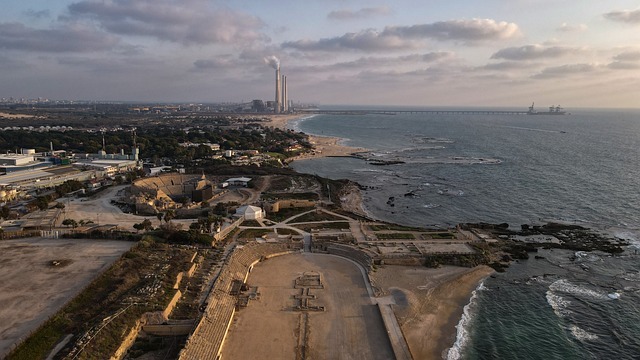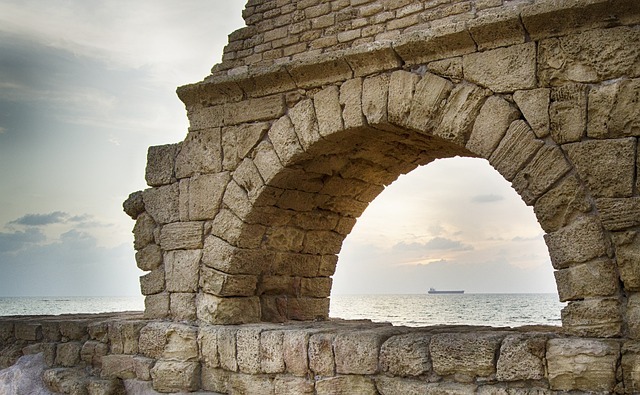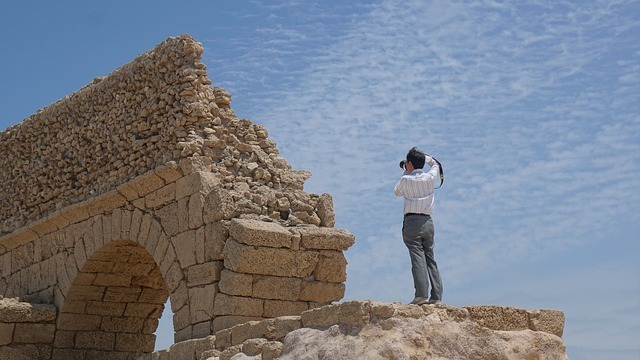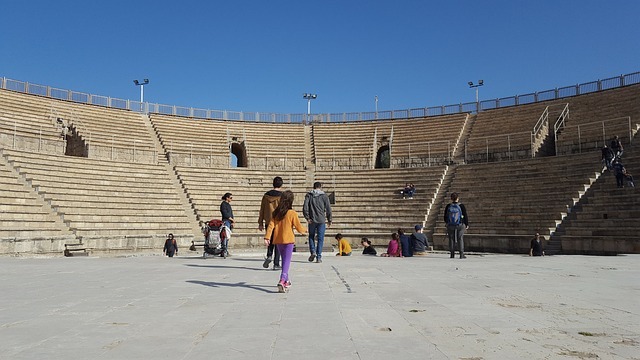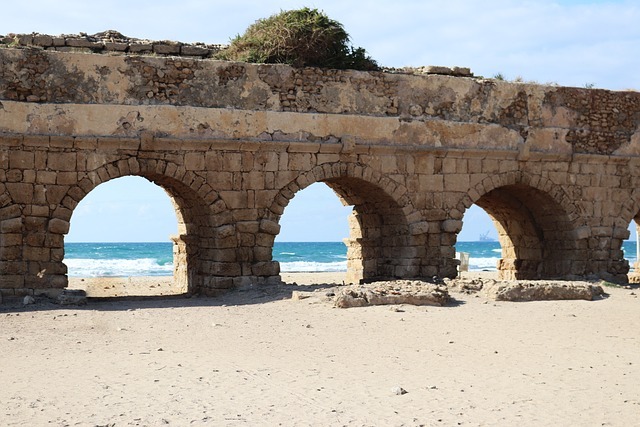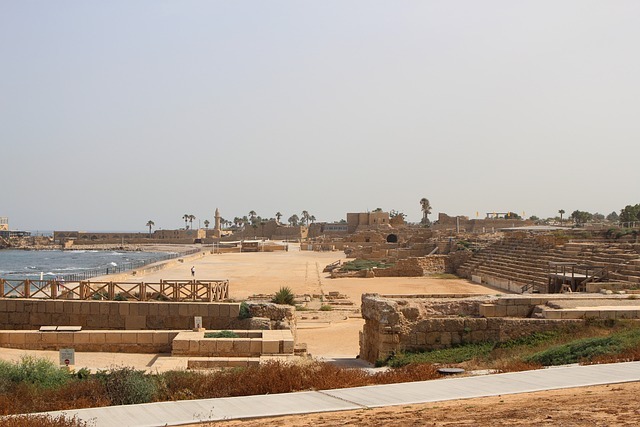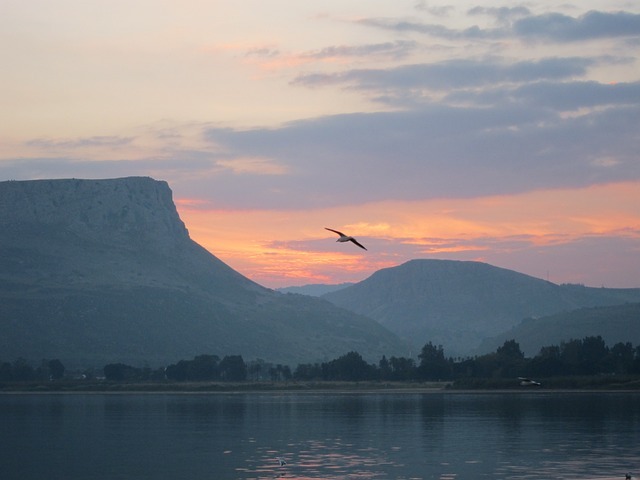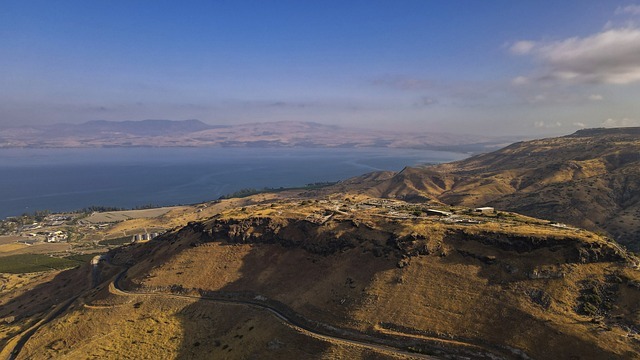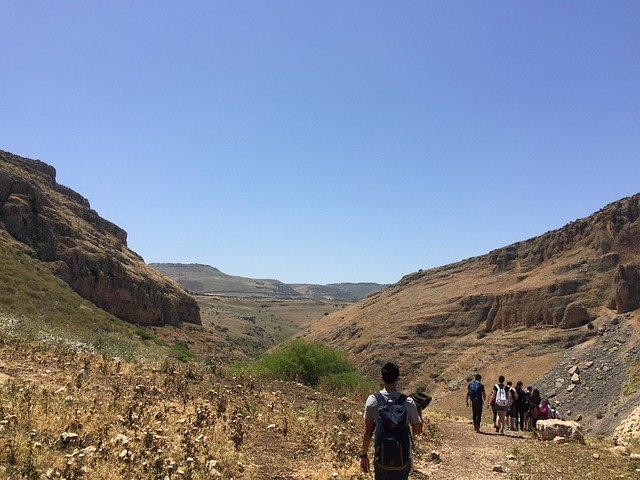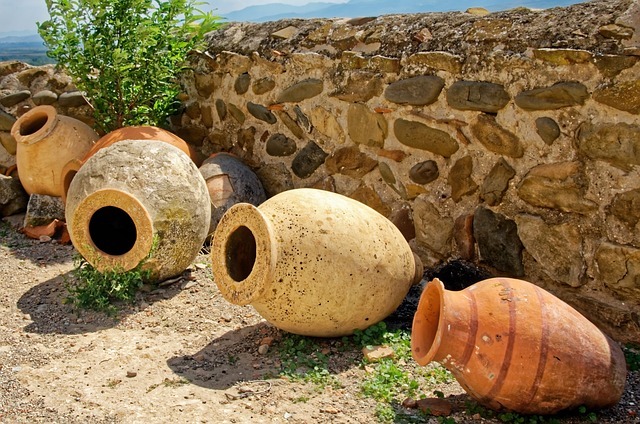CAESAREA FIELD REPORT PART 6
IV.4. The Promontory Palace.
The palace was built in two stages: We are looking down at the original Palace of Herod, which he had built into the sea, while we are standing in the upper palace of Pontius Pilate (his name was discovered on an inscription). There was some confusion about those two parts of the palace. The first excavators on this site were Netzer/Levine, while the upper part was excavated later by Sheffy, who thought the whole palace was built by Herod and not for the first Roman governor. The fact that coins from the governors period were found only under the floor of the upper part of the palace gives evidence – together with the mentioned inscription) that the upper part was built later, and not by Herod.
In the now green area to the north are the less important structures, where all activities connected to the ruling system of the area, like administrational edifices, office for taxation, inner security etc. took place. These government offices were called “praetorium”. The size of the compound surprised excavators and serves as an indication that this country did have a special status for Rome, for being hard to deal with:
Jews never connected or mingled with the Romans, and were thus seen as troublemakers (a similar situation like in the time between the two world wars under British rule).
Another reason for the overlarge administrational compound might lie in the fact that the Jewish state served as a buffer zone for the Roman Empire and the mighty Parthians(as stated already under history).
There were other problems for Rome: While on the one hand the Jewish state served as a buffer-zone, on the other hand, the Jewish state was a troublemaker, not accepting Roman rule easily, and to have the Jewish state near the border, meant also problems, similar to today’s situation of Turkey having a common border with the former UDSSR, making the US very interested in Turkey, in air-bases there etc.
Therefore, in eastern Turkey (which includes Haran and Ararat) one travels on great roads that have been built by the US. The same can be said of Ancient Israel, Rome and the Parthians with plenty of great roads with milestones.
Judea was a country with special status all around the time of Roman history, and this shows in the size of the administration.
Before excavations took place, one could only read and fantasize about those buildings, which touch upon very important points of history. Now, when most of the buildings are excavated, it is much easier to envision how Roman life was in Caesarea, and also in the whole Roman Empire.
We continue our tour to the (earlier) section of Herod’s palace which he built on rocks, a very special and bold project in every time and age!
Herod built the palace with courtyards that were surrounded by buildings, thus giving
privacy to all rooms built around the central courtyard, as there were practically no openings toward the outside.
These measures were applied by Herod not only in his palaces but in building private houses as well.
(Classical Greek architecture – in palaces the light was coming from the open courtyards to the surrounding buildings.)
Herod built 8 different palaces, most came with similar concepts.
Herod personally would probably have preferred to build palaces like the one in the north of Masada, where a side door leads to an unbelievable hanging palace on three floors. This seems more what he really would have preferred to build everywhere, open pavilions, with great views, like the view of Ein Gedi from the palace in the north of Masada.
Josephus Flavius saw the palace on Masada from the outside and commented on the “transparency” of it, with its openness, while on his other palaces Herod had to “behave” and build in the modest closed-in mode.
Therefore is was not surprising to find in Caesarea at the further-most part of the palace, facing the sea, some rooms that were open towards the sea, similar to the open pavilions found in Masada.
The palace had also two private bath-houses.
When looking down to the palace we can make out a large square area: this was a pool within the palace. It had in its middle an artificial isle with – most probably – a statue on it. It was a fresh-water pool (shells found at the sites indicated that the water was not salty sea water). The pool was surrounded by colonnades which held the roof. The palace was built probably on two floors.
The basic material used for building was limestone bedrock and kurkar.
The palace was not destroyed by any earth quakes but was clearly destroyed and looted: the closeness of the sea made it easy to steal and ship the loot off.
When looking down we can watch ongoing renovations of the beautiful mosaic that was found on the floor in the entrance to the main palace.
We walk towards the staircase leading to the lower floor of the palace.
In the far end we can see the area where the small crusader city was.
IV.5. The Hippodrome
In between is the huge space of the hippodrome.
(Hippo=horse in Greek, drom=chariot)
Josephus Flavius tells us that this is the place where in the year 9 CE. Herod celebrated the inauguration of Caesarea with an Olympiad-like contest. He invited the best sportsmen of this time, a step that was opposed by his local sports heroes for fear of not being successful. He therefore introduced two new medals – silver and bronze – to the sport event to allow his local champions a chance to win a medal (until then, only the winners received a medal).
In this hippodrome, the audience is sitting facing the sea in the same way as in the theatre except that there is no surrounding wall to conceal the view to the water, giving the audience the great view to the sea. This inclusion of nature was part of the “local culture”, together with plenty of decoration, among them the pillars around the whole arena, that was applied mainly in the eastern countries ruled by Rome and that was more sophisticated than anything else in Rome.
When Pontius Pilate introduced statues into the hippodrome the Jews reacted with fury, since the Jewish tradition does not allow the depiction of persons. When he stood up on his terrace, the Jews started to disturb, he asked his solders to interfere. But the Jews were adamant and asked to be killed rather than to be exposed to those statues.
After the death of Herod, the governors ruling after him added another tribune in the far north side in order to double the number of spectators. The hippodrome served for all kinds of performances.
(The second hippodrome – like Josephus described – was built more to the west and lies outside of today’s national park. We shall see the red protruding obelisk in its middle later when driving out of the national park.)
The hippodrome is sometimes also called “theatre” or “arena”.
To the original hippodrome, there were several amendments and additions and renovations, walls were erected to protect the audience from the wild beasts etc.
The hippodrome was changed and amended five times, before it was abandoned in the 2nd century CE, because it was too close to the sea and was flooded. That was when the other hippodrome was built.
While we are sitting in the Hippodrome, Avi (Ben Hur) reads from the book “As a driven leaf” by Milton Steinberg, describing how the 10 sages were executed brutally, like the thin Simon, and how Chanina held the Torah scrolls to his body, an account which is read during the Mussaf-prayer of Yom Kippur.
The book gives an account which is fictional but also historical.
At the far end to the hippodrome (where there is a very nice and light monument of a chariot with a driver), are the boxes in which the chariots stood before the races began. In order to have all horses start at the same exact time, a rope was pulled and released.
Also it is important to know of the many changes and renovations this hippodrome underwent during the course of the two centuries it was in use, before it was abandoned and filled with debris.

